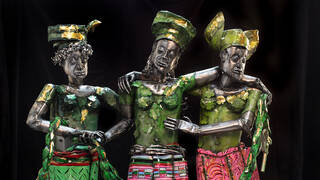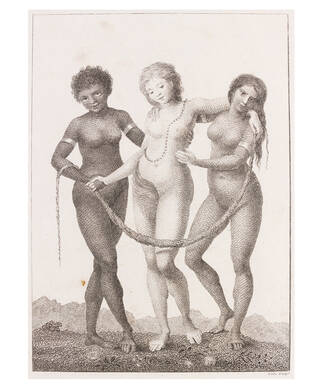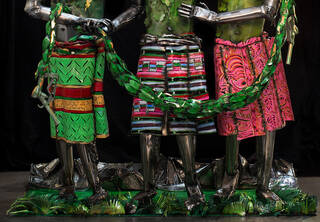British-Nigerian artist Sokari Douglas Camp is one of the leading sculptors working in Britain today.
She describes her practice as 'welding, cutting and bending sheet steel and recycled oil barrels into shape'. Drawing from her Kalabari heritage and the history of European art, she creates pieces that address socio-political issues and the history of the African Diaspora. The sculptural group on display at the V&A addresses the legacies of slavery, issues of power and gender, and the climate crisis.

Europe Supported by Africa and America (2015) is inspired by an abolitionist print by William Blake of the same title, in which the three allegorical figures representing these continents embrace. The composition is reminiscent of depictions of the Three Graces: Euphrosyne (mirth), Aglaia (elegance) and Thalia (youth and beauty), the daughters of the Greek God, Zeus. Their most famous expression in sculpture is the neoclassical marble group by Antonio Canova, shown in our sculpture galleries.

In Blake's 1796 abolitionist print, the figures are naked apart from modest ornaments – Europe wears a pearl necklace and her companions feature armlets. Douglas Camp noticed that while Blake intended to present the figures as equals, Africa and America's armlets, as signifiers of enslavement, emphasise their subjugation. Europe's modesty is preserved by her long flowing hair, while Africa and America rely on the wreath they hold – possibly made of tobacco leaf – to cover their nakedness. In Douglas Camp's version, Blake's graces are transfigured – she dresses them, and they stand united, equal in stature, adornments and attire.

Cloth plays a major role in Douglas Camp's work, in the way it expresses identity and cultural heritage. She has 'Africanized' the figures' clothing with fashionable Nigerian costumes and gèlè head ties, inspired by a family photograph of three women at a wedding in Port Harcourt, Nigeria. Dressed in this way, the figures' outfits denote the material style of each continent: Europe wears a Mondrian-like pattern; Africa a West African Kente cloth; but the artist adds to the reading of her work by dressing America in Paisley – a textile whose patterns are of Persian and Indian origins, but whose name derives from the Scottish town and centre of production of that fabric. In doing so, she reminds us that cloth carries within itself interwoven narratives of trade, often complicated by geopolitics.

Douglas Camp was born at a time when oil was discovered in the Rivers State in Nigeria, to devastating effect for the Niger Delta. In much of her work, she references the environmental and human impact of fossil fuel extraction, an economic colonialism perpetuated by multinational oil companies, but also exacerbated by bad governance from the Nigerian government. Standing on a fertile mound of grass and flowers against a mountainous backdrop, the wreath her Graces hold ends in petroleum nozzles, emphasising our shared responsibility to care for the environment.
See Europe Supported by Africa and America in Gallery 21, The Dorothy and Michael Hintze Galleries, from 22 June 2022.
This display coincides with the V&A exhibition Africa Fashion.

